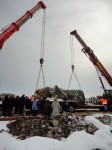 In late 2010, archaeologists excavating a Celtic cemetery near the Iron Age settlement of Heuneburg unearthed an intact grave. The rest of the cemetery had been extensively looted, so when the team found a gold brooch inside a wooden burial chamber, they realized they had a very special find on their hand. The timbers were preserved in soil waterlogged by a small river that flowed nearby, which may also be the reason the grave was never pillaged. Its water-filled interior and boggy soil made it difficult for would-be thieves to access and loot. With a cemetery full of graves on drier land, looters picked the path of least resistance.
In late 2010, archaeologists excavating a Celtic cemetery near the Iron Age settlement of Heuneburg unearthed an intact grave. The rest of the cemetery had been extensively looted, so when the team found a gold brooch inside a wooden burial chamber, they realized they had a very special find on their hand. The timbers were preserved in soil waterlogged by a small river that flowed nearby, which may also be the reason the grave was never pillaged. Its water-filled interior and boggy soil made it difficult for would-be thieves to access and loot. With a cemetery full of graves on drier land, looters picked the path of least resistance.
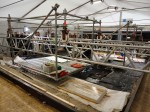 On December 28, 2010, the whole grave, encased in a 25-by-20 foot soil block weighing 80 tons, was raised and transported to the laboratory of the State Office for the Preservation of Monuments in Stuttgart. Archaeologists could now excavate the burial chamber in protected conditions, preserving the prehistoric timbers and any other organic remains, no matter how minute, and take all the time they needed for a thorough excavation. They discovered the contents of the tomb were extremely rich: more than 40 pieces of gold jewelry, more than 100 pieces of
On December 28, 2010, the whole grave, encased in a 25-by-20 foot soil block weighing 80 tons, was raised and transported to the laboratory of the State Office for the Preservation of Monuments in Stuttgart. Archaeologists could now excavate the burial chamber in protected conditions, preserving the prehistoric timbers and any other organic remains, no matter how minute, and take all the time they needed for a thorough excavation. They discovered the contents of the tomb were extremely rich: more than 40 pieces of gold jewelry, more than 100 pieces of 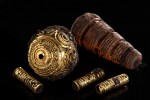 amber, plus jet, bronze and boar tusk jewelry and accessories, and an ornamental piece of armour for the head of a horse. This kind of armor was not produced in the Heuneburg area at this time. Part of it is consistent with work produced in northern Italy; some elements appear to be of southern Italian origin. It’s a testament to the variety and extent of the interregional trade in luxury goods during the Early Iron Age.
amber, plus jet, bronze and boar tusk jewelry and accessories, and an ornamental piece of armour for the head of a horse. This kind of armor was not produced in the Heuneburg area at this time. Part of it is consistent with work produced in northern Italy; some elements appear to be of southern Italian origin. It’s a testament to the variety and extent of the interregional trade in luxury goods during the Early Iron Age.
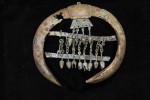 Most of the jewelry was adorned the skeletal remains of an adult woman. Her immense wealth and the wooden burial chamber, the only one of its kind every found, point to her being in the top echelon of Heuneburg society. The Celtic Princess of the Danube, as the press dubbed her, was between 30 and 40 years old when she died. The trunk of her skeleton was articulated and in place, while the skull was 10
Most of the jewelry was adorned the skeletal remains of an adult woman. Her immense wealth and the wooden burial chamber, the only one of its kind every found, point to her being in the top echelon of Heuneburg society. The Celtic Princess of the Danube, as the press dubbed her, was between 30 and 40 years old when she died. The trunk of her skeleton was articulated and in place, while the skull was 10 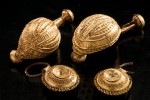 feet away and the mandible in a corner of the chamber. Also in the grave were the remains of young girl around two or three years old. She too wore jewelry and because it is very similar to that found on the adult woman, so similar it was probably created by the same goldsmith, archaeologists believe they were related, likely mother and daughter. According to Dirk Krausse of the State Office for Cultural Heritage, Baden-Wuerttemberg, the matching jewels are “very special. We have no parallels to compare from the other graves. They’re only known up to now from these two graves.”
feet away and the mandible in a corner of the chamber. Also in the grave were the remains of young girl around two or three years old. She too wore jewelry and because it is very similar to that found on the adult woman, so similar it was probably created by the same goldsmith, archaeologists believe they were related, likely mother and daughter. According to Dirk Krausse of the State Office for Cultural Heritage, Baden-Wuerttemberg, the matching jewels are “very special. We have no parallels to compare from the other graves. They’re only known up to now from these two graves.”
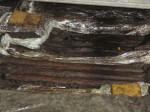 The style of the jewelry suggested a 7th century B.C. date for the grave. The preserved wooden timbers gave a more precise date: they were cut from a fir tree in 583 B.C. This was a prosperous time at Heuneburg. The Heuneburg hill fort dates to the Hallstatt period or Early Iron Age. The remains of wood and earthwork defensive fortifications from around 700 B.C. have been found, as have houses, burial mounds and expensive imported artifacts. A mud brick citadel wall on a massive limestone foundation 20 feet high was
The style of the jewelry suggested a 7th century B.C. date for the grave. The preserved wooden timbers gave a more precise date: they were cut from a fir tree in 583 B.C. This was a prosperous time at Heuneburg. The Heuneburg hill fort dates to the Hallstatt period or Early Iron Age. The remains of wood and earthwork defensive fortifications from around 700 B.C. have been found, as have houses, burial mounds and expensive imported artifacts. A mud brick citadel wall on a massive limestone foundation 20 feet high was  built around 600 B.C., a unique feature for Celtic settlements of this period. From 620 to 470 B.C., an estimated 10,000 people lived in Heuneburg which makes it by far the largest known prehistoric settlement north of the Alps as well as one of the oldest. More recent excavations at the foot of the hill have discovered a secondary housing site with homes grouped in walled compounds, an Iron Age suburban gated community, if you will. This is evidence in favor of classifying Heuneburg as not just a settlement, but an urban center. If so, it would make the hill fort the oldest urban site north of the Alps.
built around 600 B.C., a unique feature for Celtic settlements of this period. From 620 to 470 B.C., an estimated 10,000 people lived in Heuneburg which makes it by far the largest known prehistoric settlement north of the Alps as well as one of the oldest. More recent excavations at the foot of the hill have discovered a secondary housing site with homes grouped in walled compounds, an Iron Age suburban gated community, if you will. This is evidence in favor of classifying Heuneburg as not just a settlement, but an urban center. If so, it would make the hill fort the oldest urban site north of the Alps.
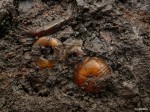 The remains of one other adult woman were found in the burial chamber. She had no jewelry, so researchers suspect she was a servant. At the moment it is not possible to determine whether and how the three individuals in the grave were related to each other.
The remains of one other adult woman were found in the burial chamber. She had no jewelry, so researchers suspect she was a servant. At the moment it is not possible to determine whether and how the three individuals in the grave were related to each other.
Biological remains have been retrieved from the woman’s skeleton, but there are not enough remains from the child to do a DNA test, Krausse said. Only the enamel from the child’s teeth now remains.
At the moment, DNA sequencing technology is not advanced enough to work on the fragments of biological remains from the child’s grave. “But in 10 years, 20 years, maybe we will have the technology,” Krausse said.
The research into the Heuneburg grave and its contents is slated to continue until 2018. The latest findings will be published in the journal Antiquity.